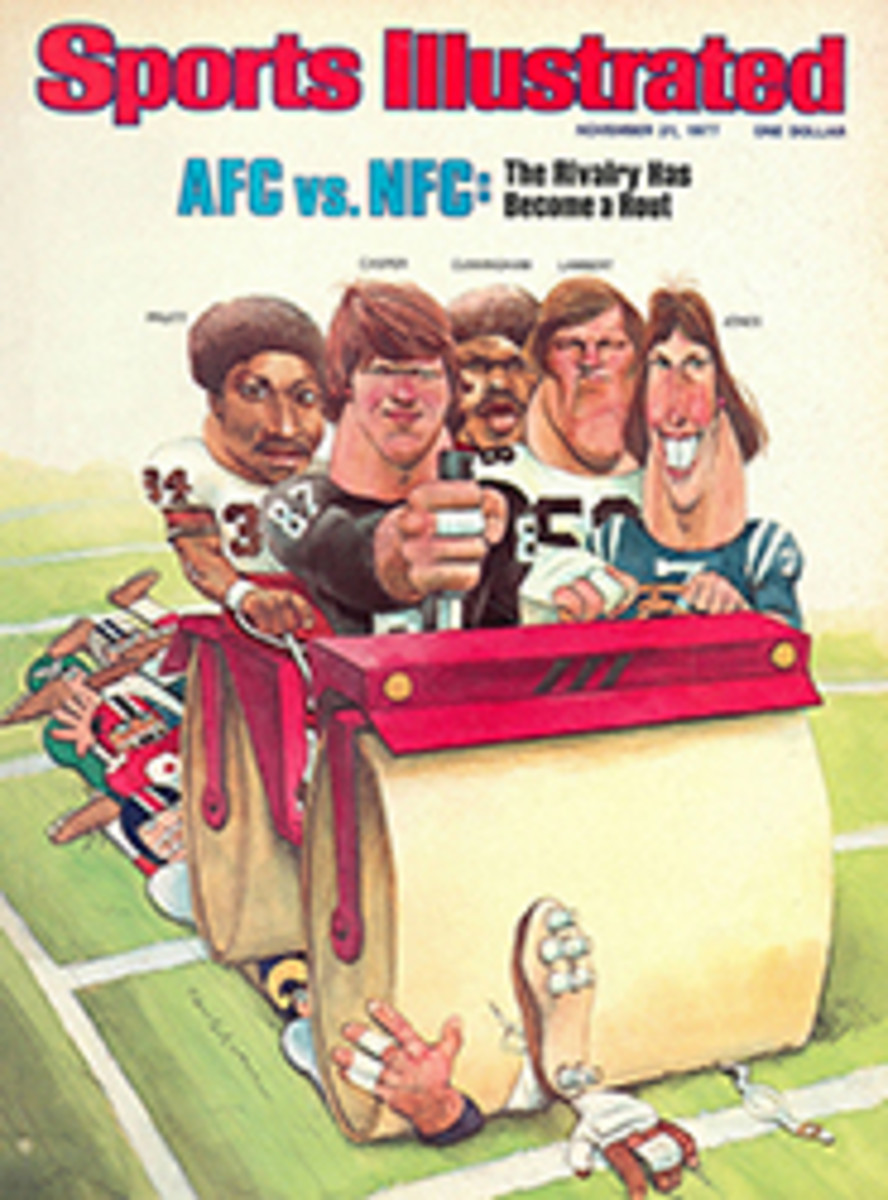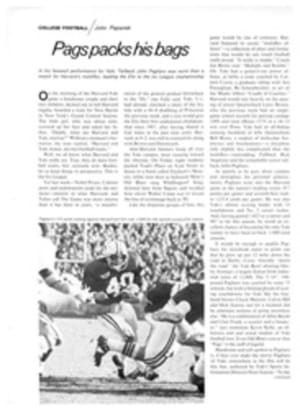
A thriller for the downhillers
From the start it was generally agreed that skateboard racing was an activity with all the moves. What it lacked was a sense of, well, direction. But now that the effects of the first annual Catalina Classic have spread throughout the sport, its advocates feel they have the one event that will attract attention like nothing has before. The event is called downhill racing.
Professional skateboard racing has been rolling along for two years now, and while there had been a handful of downhill races, they had not been notably successful. The courses were mostly straightaways, which made a race thrilling for the racer because of the speed but boring for the spectator because the skateboards didn't seem to be doing anything. They might as well have called it the downhill plummet. But the contest on Santa Catalina Island a few weeks ago offered some twists. The course was laid out on a 250-meter stretch down one of hilly Avalon's steepest streets, that has about a 34 degree-or-so pitch. It included two 135-degree turns—back to back, no less—followed by a fast sweeper to the left and a pylon-marked, snaking run to the finish. The downhill fascinated the spectators who had ferried over from the mainland and generally convinced folks that the sport can get organized now that it has something strong to organize around.
Exactly the sentiment of a gentleman named Peter Camann, who took his five years of experience as an organizer of ski races and formed a small production company called Another Roadside Attraction, after the Tom Robbins novel of the same name. Last summer Another Roadside Attraction promoted five professional skateboard races in Colorado, three of them downhills of the let-'er-rip category—that is, without curves. When Southern California promoter H. Allan Seymour II convinced the Avalon City Council that its Marilla Avenue should be the birthplace of the new style of downhill skateboard racing, he hired Camann to organize the event.
To the surprise of most spectators, the racers weren't all kids. In fact, the top three were 23, 25 and 26 years old, and two of them do nothing but race skateboards for a living. John Hutson, 23, the winner, allowed that "When I tell people I'm a professional skateboard racer, they think I'm kidding. But I take this very seriously." Hutson has been riding skateboards since he was 11 and makes about $15,000 a year with the Santa Cruz skateboard factory team. During the racing season he trains two or three hours a day—mostly riding but also lifting weights and swimming (he attended the University of Hawaii on a swimming scholarship). By winning the Catalina Classic, Hutson completed a sweep of the year's races.
Things would not have rolled so smoothly for Hutson this year if he had had to contend with Bob Skoldberg, 25, another 12-year veteran of skateboarding, who had won all the races the previous year. But Skoldberg had spent the summer making a promotional tour through Europe for Hobie skateboards. He flew in to Catalina from Germany just for the Classic and returned the following Monday to finish the tour, with demonstration stops in London, Paris and Switzerland.
There is a sign at the top of the hill on Marilla Avenue that says DANGER: WALK BIKES DOWN HILL. Obviously, it was put there in the pre-skateboard era. The downhill course started at the top of the street with the double-hairpin turn. On the outside of the first hairpin there is a weather-beaten white wooden fence, with a cliff on the other side. On the outside of the second hairpin there is a stone wall, which for the race was cushioned by hay bales. The good skaters used all of the road, like Formula I race car drivers, and at times their urethane wheels actually drifted on the pavement. Their ankles nearly scraped the curb on the outside of the first hairpin, and they accelerated into the second hairpin—whether they liked it or not. As they drifted out of that turn, wheels chattering, their backsides and elbows brushed the hay bales. Then the course straightens and levels slightly, and the skaters crouched into a tuck, in which their heads were down and their fannies up. It is a position that allows for little maneuvering of the board but the tuck is necessary to reduce wind resistance and increase speed. Then the skaters straightened a bit and powered their boards through the pylons, crisscrossing the street at about 25 mph to the electronic timing lights at the finish line.
Skateboarders talk a lot about "get-off speed," which is simply the speed at which the skater can get off the board and run. If the skateboard is traveling below that speed, losing balance and stepping off the board without falling is easy enough; above that speed, however, stepping off is sort of like jumping from a moving train. On Marilla Avenue, the get-off speed was reached at just about the point where the stone wall began.
Stone walls and get-off speeds notwithstanding, injuries more serious than raspberries are rare among racers. The fully protected racer will wear high-top sneakers, ankle pads, fiber-glass knee and elbow pads, shorts with a leather crotch and hipbone, tailbone and pelvic bone pads, wrist braces, leather gloves and a helmet. Some even wear motorcycle racing leathers.
Marilla Avenue was lined with 2,500 people—kids and adults, tourists and locals—crowding the curbs and looking down from wooden balconies of colorful old buildings like the Hermosa Hotel. Some of the spectators bore badges of their skateboarding enthusiasm: charcoal-colored smudges on their hips and bellies and shoulders, like red dirt on a base stealer's uniform, the result of brushes with the ground. Said one grandmother, a lifelong resident of Catalina, "When we were kids we used to think "it was so thrilling and dangerous merely to ride our wagons down this hill. But this is really something. I just called my daughter in Utah and said, 'You're not going to believe what's going on here.' "
When the racing began, Skoldberg crashed heavily on one of his warmup runs—he had arrived in Catalina from Germany late the night before and he had missed the day of practice and qualifying. But on his second of three official runs (the two best count) he had the fastest time of the day, 26.969 seconds. That moved him into second place going into the final run, behind Jamie Hart, a 26-year-old truck-parts dealer who practices on a 3.1-mile stretch of highway on Donner Summit near Lake Tahoe—at speeds of 40 mph. Hutson, the favorite, was third, but less than .08 of a second separated the three.
In the final run Skoldberg's fatigue got the best of him, and a relatively slow time knocked him out of contention. Hart's final run was also slower than his first two, but only slightly. Now the pressure was on Hutson, and in the last run of the contest, against an uphill breeze, he responded by clocking his best time, 27.042, to beat Hart by .265 of a second. Hart summed up the feelings of most of the racers when he said, simply, "Now, this is really the way downhill racing should be done."
The Classic also offered a slalom race for both men and women, an event less exciting than the downhill but impressive in its own way. Hutson just missed a double for the weekend when he was edged by .091 of a second in the finals by Bobby Piercy, a former slalom skier. "Skateboarding is almost identical to skiing if you keep your feet parallel on the board," says Piercy. "You use the same muscles that you use in skiing, you use the same principles in carving turns and following the fall line, you even use the same mental approach."
As the sun set over the island's peaks and the whizzing sound of urethane wheels rolling over the cement streets echoed through Avalon, Seymour hiked up Marilla Avenue, stood at the top of the hill and watched in satisfaction as the last ferry of the day steamed away toward the mainland. Then he smiled and said, "They said I was nuts, that a downhill race like this would never work, let alone one on an island, but I never had any doubts." The smile spread into a broad grin. "I already know I'm not normal, and this confirms that at least there are a lot of people out there just about as nuts as I am."
PHOTO
Chasing his shadow to victory, downhill champion John Hutson made it a clean sweep for the season.
PHOTO
Before jet lag got to him, runner-up Bob Skoldberg jetted through the turns in the Catalina race.

